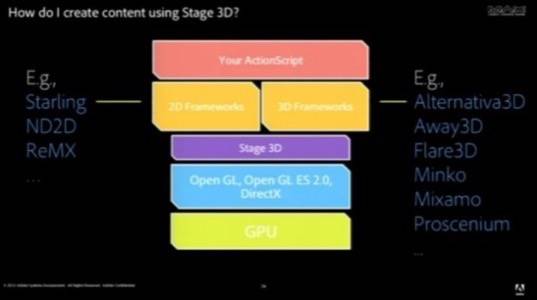Microsoft earned a reputation for its “embrace and extend” development philosophy, which recalls a time when it assimilated existing ideas by hook or by something else. Adobe’s plan with respect to HTML5 technology is more like “embrace and pummel.” Although it’s been telling analysts and reporters that Flash is embracing HTML5, the message Adobe’s product managers gave to developers this week at its MAX 2011 conference is that the plug-in reigns supreme.

Sensing a crack in the dam from Microsoft on Windows 8, Adobe crafted a message for Flash developers this week about heterogeneity that had nothing at all to do with HTML5. Microsoft premiered its WinRT-based Metro, or “Metro-style,” apps model as a native platform using HTML5 that lets Windows “gracefully get out of the way” (Microsoft’s words, not mine). Adobe’s response is that the AIR 3 platform for Flash 11:
1. Can render 2D or 3D content as much as 1,000 times faster than its predecessor by bypassing the existing software-based rendering engine and connecting directly to the GPU hardware;

2. Utilize both proprietary and independent, open source frameworks (one example being Starling) that many developers already know, giving them a choice of facilities for expressing their graphics and an easy way to import their existing assets;
3. Minimize the overhead of Adobe’s new Stage3D rendering engine and API, to let these existing frameworks do what they already do best; and,
4. Promote a single development model for desktop applications and mobile apps, as opposed to a bipolar environment where one model “gracefully gets out of the way” to make room for the other.
“Our goal with the Flash platform is to allow you guys to build mobile content, mobile applications, in-browser content on mobile devices that looks like the same experience you get with native applications, and the same experience you get on the desktop and the browser,” Adobe senior product manager Scott Castle told developers at MAX 2011. “The consistency in the runtimes across Flash Player and AIR on the desktop and on mobile and on TV is very important to us and to you, and we want to make that consistent so that the mobile experience on all the tablets I see you guys holding and taking pictures of me with, is consistent with the desktop machines that you’re already targeting, and on the iPhones and the Android devices and the BlackBerry PlayBooks that you’re already using.”

In live demos this week of 3D games created using the Stage3D API and various frameworks, Flash Player product managers Thibault Imbert and Tom Nguyen showed graphically resplendent 3D browser-based games. They weren’t significantly more amazing than 3D games within the last five or six years… and frankly, that’s the point. 3D graphics performance was pretty darn good – at least on a par with anything DirectX or OpenGL game installed directly to a PC – and some of the screens they were playing on were mobile.

The reason, the Adobe managers revealed, was that the graphics frameworks – including Adobe’s own 3D framework, called Proscenium – are leveraged on the DirectX and OpenGL libraries (OpenGL ES 2.0 for mobile).

“People are asking us, ‘So how do you take advantage of Stage3D? Do I need to learn, like, crazy shader languages and write low-level code?’ And the answer is, you don’t,” pronounced Flash product manager Tom Nguyen. “You have the option, so you have incredible power at your disposal if you want to dig into it. But you’ll also be able to take advantage of these 2D and 3D frameworks that are built on top of Stage3D.
“Part of the reason for making it such a thin layer, from a Flash platform perspective,” Nguyen continued, “is that we want to enable a whole ecosystem of different frameworks that can build on top. So if you’re building a first-person shooter game, you can use a framework that’s optimized for that; if you want to do a casual, 2D social game, you can do that, with a truly optimized framework designed just for it.”
Distribution of the Flex and Flash Builder 4.6 builder tools for AIR and Flash, respectively, begins this quarter. Tablet apps developers will appreciate new features in the 4.6 platform such as the ability to defer to the tablet’s native controls for text entry (especially for iOS and Android), rather than emulate controls that look like the native ones.
Granted, the major business model around AIR apps at the moment is gaming, and the AIR demos certainly reflected that. By comparison, last month’s Windows 8 demos included some casual 2D games (good ones), but more on a par with Flash six years ago. Nonetheless, if Adobe was supposed to be embracing HTML5 at its party this week, it ended up – as we’d say back in Oklahoma – dancing with the partner that brung it.










